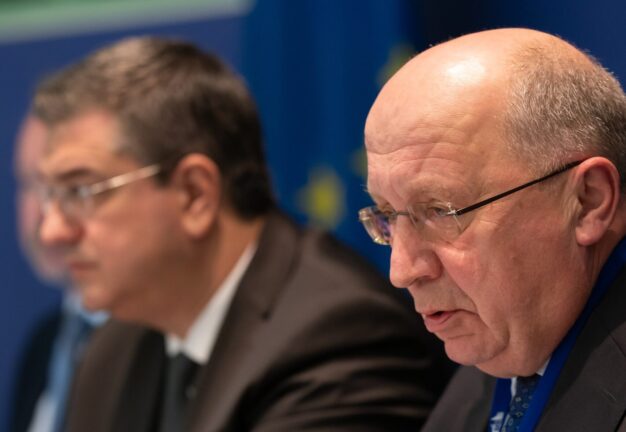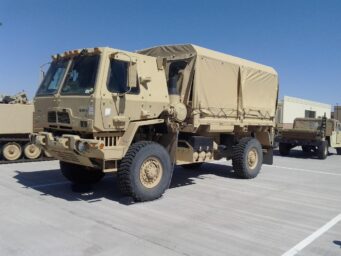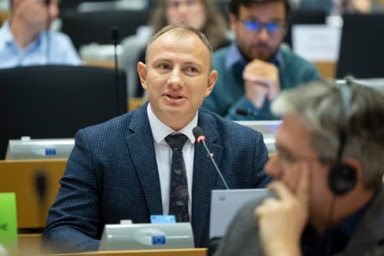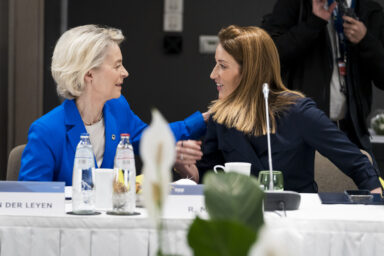Europe’s lawmakers have given their blessing to a plan for faster troop movements, while the Commission has unveiled a package to make it happen. The Commission’s new rules promise to cut red tape and upgrade infrastructure—so that, as Defence Commisioner Andrius Kubilius put it, “infantry wins battles, logistics wins wars.”
The European Parliament’s joint committees on Security and Defence (SEDE) and Transport and Tourism (TRAN) approved a draft own-initiative report on military mobility on November 24th. The motion passed with a solid majority—56 votes in favour, 11 against, and two abstentions. The report underpins the Parliament’s stance on complementing the forthcoming European Commission’s Military Mobility Package, set for release later this year.
The TRAN co-rapporteur, Roberts Zīle (ECR/LAT), noted the complex collaboration between committees with distinct areas of expertise. “It was, of course, more difficult to have two committees with a different experience in different areas,” he said, commending the work shared with fellow co-rapporteur Petras Auštrevičius (Renew/LTU) and the shadow reporters.
Timing was a challenge, too. Mr Zīle explained: “We wanted to finalise our initiative report before, or at the same time, like commission coming out with your legal proposal.” Though they could not finish months ahead, he judged the compromise sensible, especially maintaining geographical balance on the EU’s four military mobility corridors. He described the agreement as “low-hanging fruits like military Schengen,” a “good compromise.” “I think we made a good proposal,” he added, conceding that not everyone was “100 per cent happy.”
You might be interested
A question of political will
Mr Auštrevičius, the SEDE co-rapporteur, welcomed the outcome warmly. “I am very happy with the outcome of our deliberations and meetings and technical meetings,” he said. “Mobility is everything. Once we are mobile, we bring food where the mouth is.” His emphasis rested on the need to increase and deploy capacities to regions demanding them. Mr Auštrevičius called for broad approval and highlighted the excellent cooperation between himself and Mr Zīle alongside all involved committees and shadow reporters.
The draft report supports the Commission’s planned measures, which include a joint communication, a regulation and amendments to existing laws designed to clear infrastructure bottlenecks, procedural hurdles and capability gaps. These obstacles currently slow military transportation and deployments across member states. The Parliament urges member countries to fully utilise EU funding mechanisms, particularly the Connecting Europe Facility, to upgrade key transport infrastructure and assets for defence purposes.
A priority identified in the report is establishing a “military Schengen area.” This concept promises drastic simplification and harmonisation of cross-border procedures such as customs clearance, transport of dangerous goods and diplomatic authorisations. The Parliament presses the Commission for a clear roadmap towards this goal. Digitalising and standardising procedures to prioritise armed forces on transport networks would reduce delays when crises arise.
Integrating mobility into EU policy
The report takes a broader view, asserting that military mobility must integrate seamlessly with EU policies on transport, energy and taxation. Boosting infrastructure resilience is deemed vital to European security and defence. Parliamentarians call for urgent alignment of divergent national rules to eliminate “national silos” hindering multinational operations. The report also highlights the need to accommodate increased defence spending within EU fiscal frameworks, securing resources for military mobility projects.
Much more than a technical document, the report exemplifies the European Parliament’s political will and detailed recommendations. It aims to influence the Commission’s proposals, demanding they be ambitious, well-funded and harmonised across the bloc. Parliament advances a vision of simplification, investment and seamless coordination, crucial to enabling rapid deployment in response to emerging threats. These recent geopolitical tensions underscore the urgency of taking the strategy beyond words.
Mr Zīle encapsulated the spirit of the report, saying, “We did our best,” while Mr Auštrevičius stated, “I think we have very good compromises,” laying a hopeful foundation for Europe’s military mobility future.
The Commission package
Imediately after the vote, the joint committee session moved on to hear the presentation of the mobility package by Commissioners Apostolos Tsitsikostas (transport and tourism) and Andrius Kubilius (defence and space). The package aims to speed up and simplify troop and equipment movements across the bloc, MEPs heard. Mr Tsitsikostas spoke of “the urgency of strengthening military mobility” and the “concrete steps” now agreed. “Robust logistic networks can determine the difference between winning and losing a war,” he said.
Military mobility is not only about moving equipment. It’s about preparedness, resilience. —Apostolos Tsitsikostas, EU transport commisisoner
The Commissioner stressed that the package does not propose new infrastructure built from scratch. Instead, the plan adapts existing civilian networks for dual military and civilian use. This means “safer, stronger, and more resilient” infrastructure for all Europeans. Regulatory simplification and upgrades along military mobility corridors form two keystones of the plan. Uniform rules for military transport across member states—especially when private companies are involved—will replace the current patchwork. “The level of simplification must reflect this exact context,” he said, distinguishing peacetime and emergencies.
Bridges and tunnels must be able to carry heavier vehicles and permit transit during weekends and holidays, when bans currently apply in some countries. The package also aligns with the trans-European transport network, leveraging more than 30 years of investment to connect major cities, ports and inland waterways. Mr Tsitsikostas highlighted completed projects, such as widened sections of the Via Baltica in Lithuania and reinforced bridges in Poland that now support vehicles up to 130 tons. These upgrades demonstrate tangible progress while benefiting civilian users. “Military mobility is not only about moving equipment. It’s about preparedness, resilience,” he said.
Simplifying borders
Mr Kubilius echoed these priorities and emphasised the strategic significance of military mobility. Citing US General John Pershing— EU Transport and Tourism Commisisoner —he hailed the package as a crucial step forward. Mr Kubilius recalled a meeting with EU chiefs of defence, who said they had “been waiting 10 years” for such coordinated action. One major reform replaces the chaotic patchwork of 27 national regulations with a single European rulebook. (The following debate featured more quotes of dostinguished military figures, including US General—and, later, US President—Dwight Eisenhower and Napoleon Bonaparte.)
In wartime, border permits will no longer be required for military movements—notification will suffice, the Lithianina commissioner said. Peacetime standing permits, valid across all member states for up to three days, will shorten waits dramatically compared with current delays that often last months. The package addresses customs procedures, transport of dangerous goods and exempts military convoys from traffic bans and cabotage rules.
Infantry wins battles, logistics wins wars. — Andrius Kubilius, EU defence commissioner
The plan establishes a “military mobility solidarity pool,” encouraging voluntary sharing of transport assets—including wagons, trucks and strategic airlift capacities. This pool, managed by the Commission, aims to close gaps in availability. A common emergency framework, named EMERS, can be activated by the Council when needed to coordinate support swiftly. Mr Kubilius also underlined the regulation’s “resilience toolbox” to protect dual-use infrastructure, supported by nearly €18 billion budgeted under the next multi-annual financial framework.
Coordinating readiness
A governance mechanism is a further innovation. The package introduces a cross-institutional military mobility transport group and national coordinators responsible for synchronising efforts across member states. It also mandates annual readiness checks and stress tests. The first will simulate rapid military assistance deployments towards Ukraine and the EU’s eastern borders.
“Our goal to have defence readiness by 2030 will not be implemented without military mobility and without this regulation,” Mr Kubilius warned, urging swift parliamentary adoption and agreement with the Council. Both commissioners emphasised that faster movement is not merely a military imperative but feeds into Europe’s broader security and resilience. “The geopolitical situation now in the world is not easy,” said Mr Tsitsikostas. “We have to learn to move faster, to work harder… to bring results much earlier than expected.”
Europe’s new package is a step towards the much-discussed but elusive “Military Schengen,” envisaging borderless military movement across the continent. The road ahead still demands heavy investment, cooperation and political will. But as Mr Kubilius put it, “infantry wins battles, logistics wins wars.”
The presentation enjoyed almost universal support among the MEPs present. The goal of making the future of Europe’s military logistics more straighforward just got a tiny step closer.











